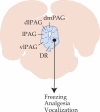Placing prediction into the fear circuit
- PMID: 21549434
- PMCID: PMC4245078
- DOI: 10.1016/j.tins.2011.03.005
Placing prediction into the fear circuit
Abstract
Pavlovian fear conditioning depends on synaptic plasticity at amygdala neurons. Here, we review recent electrophysiological, molecular and behavioral evidence suggesting the existence of a distributed neural circuitry regulating amygdala synaptic plasticity during fear learning. This circuitry, which involves projections from the midbrain periaqueductal gray region, can be linked to prediction error and expectation modulation of fear learning, as described by associative and computational learning models. It controls whether, and how much, fear learning occurs by signaling aversive events when they are unexpected. Functional neuroimaging and clinical studies indicate that this prediction circuit is recruited in humans during fear learning and contributes to exposure-based treatments for clinical anxiety. This aversive prediction error circuit might represent a conserved mechanism for regulating fear learning in mammals.
Crown Copyright © 2011. Published by Elsevier Ltd. All rights reserved.
Figures





References
-
- Davis M. The role of the amygdala in fear and anxiety. Ann. Rev. Neurosci. 1992;15:353–75. - PubMed
-
- LeDoux JE. Emotion circuits in the brain. Ann. Rev Neurosci. 2000;23:155–84. - PubMed
-
- Maren S, Quirk GJ. Neuronal signalling of fear memory. Nat. Rev. Neurosci. 2004;5:844–852. - PubMed
-
- Sigurdsson T, et al. Long-term potentiation in the amygdala: a cellular mechanism of fear learning and memory. Neuropharmacology. 2007;52:215–227. - PubMed
-
- Medina JF, et al. Parallels between cerebellum- and amygdala-dependent conditioning. Nat. Rev. Neurosci. 2002;3:122–131. - PubMed
Publication types
MeSH terms
Grants and funding
LinkOut - more resources
Full Text Sources

